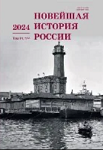Унификация и формализация выборов руководящих органов ВКП(б) в 1937–1941 гг.
Unification and Formalization of Elections to Party Committees in 1937–1941
Author(s): A. N. FedorovSubject(s): Government/Political systems, Electoral systems, Interwar Period (1920 - 1939), WW II and following years (1940 - 1949), History of Communism
Published by: Издательство Исторического факультета СПбГУ
Keywords: J.V. Stalin; Great Purges; inner-party democracy; party committees; prewar period; secret ballot; Central Committee;
Summary/Abstract: The article is devoted to the changes in the election of regional and local committees of the All-Union Communist Party of Bolsheviks that occurred in 1937–1941. The research is based on the documents of the Russian State Archive of Contemporary History, the Russian State Archive of Social and Political History and a number of regional archives. Until the second half of the 1930s there were no uniform rules for holding elections; they were held sporadically and formally, since lists of candidates were prepared in advance, and voting was open. In the spring of 1937, the top leadership introduced uniform and more democratic procedures — free nominations of candidates and secret ballot. The hasty implementation of these procedures led to the fact that 1937 party elections were poorly organized and lasted very long. To improve their organization the Central Committee restricted the use of secret balloting, but this was not enough. Moreover, in 1938 a new problem emerged — party activists began to vote against their leaders more often. The election of delegates to the XVIII Party Congress showed that the protest vote has intensified: many regional leaders were blackballed, not elected or received a large number of “no” votes. In these circumstances, the center has significantly adjusted the initial principles and procedures. Most importantly, instead of free nomination of candidates, they returned to their preliminary selection by a narrow circle of leaders. The party conferences of 1940 showed that this “innovation” not only shortened the time of the elections, but also actually abolished their alternative, as candidates were nominated as many as it was necessary to elect. As a result, the completely democratic electoral system introduced in 1937 was completely unified, formalized and regulated by 1941 in such a way that elections became as manageable and predictable as possible.
Journal: Новейшая история России
- Issue Year: 14/2024
- Issue No: 49
- Page Range: 905-921
- Page Count: 17
- Language: Russian

